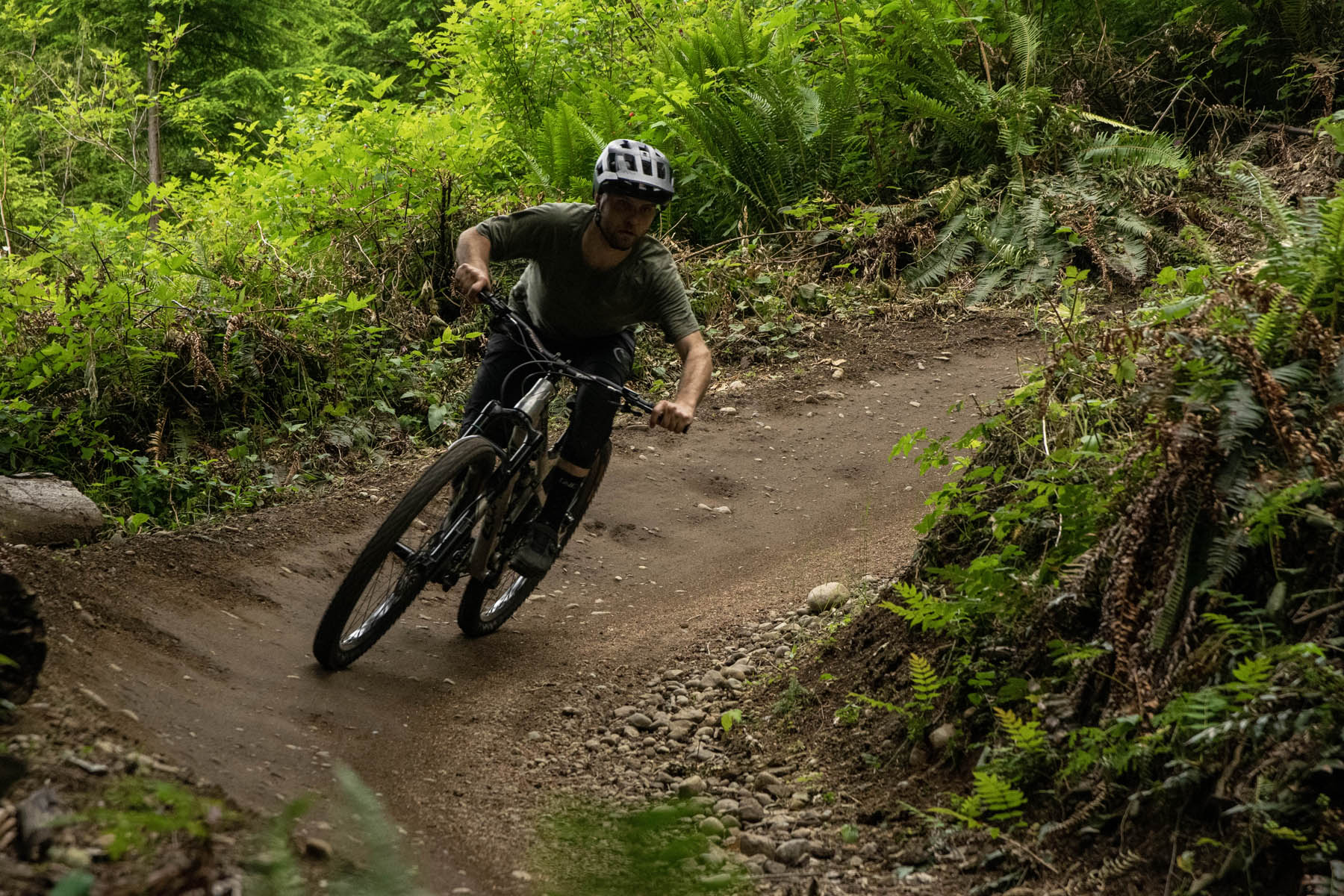
Intro
Our 2022 Knee Pad Roundup included a ton of options across a wide range of design styles and levels of beefiness — most of which are still current models — but we’ve been testing a handful more, so we figured it was time for another roundup with some additional options. We’ve carried over the models from last year’s iteration that are still current, added some more options, and tweaked the comparisons of the models we previously reviewed to reflect how they stack up against the newcomers.
MSRP: $110
Reviewer: David Golay (6’, 170 lb / 183 cm, 77.1 kg)
Size tested: Medium
Measured weight per pad: 183 g
Certification: CE EN 1621-1 Level 1
Akta is a new brand based in North Vancouver, BC, and while the Trail Knee Pad is their first (and so far only) protection offering, it’s remarkably dialed and has become one of my favorite options for a comfortable pedal-friendly pad that’s still reasonably protective. It’s a sleeve-style pad with no adjustable straps to mess with, but does add a fixed-length elastic strap that sits on top of the calf muscle to help keep the pad from sliding down.
Otherwise, the sleeve design is fairly typical for this style of pad — the sides are lycra, with a stretchy mesh fabric used on the rear of the pad, and a tougher, more abrasion-resistant face fabric on the front. There’s an elastic upper band with medium-aggressive silicone grippers lining it, and a much smaller strip of silicone around the lower hem as well. The upper part of the sleeve extends fairly far up the thigh (where there’s much less bending and other movement as you pedal) but it’s a little shorter than the 7iDP Transition or Sam Hill (see below), for example.
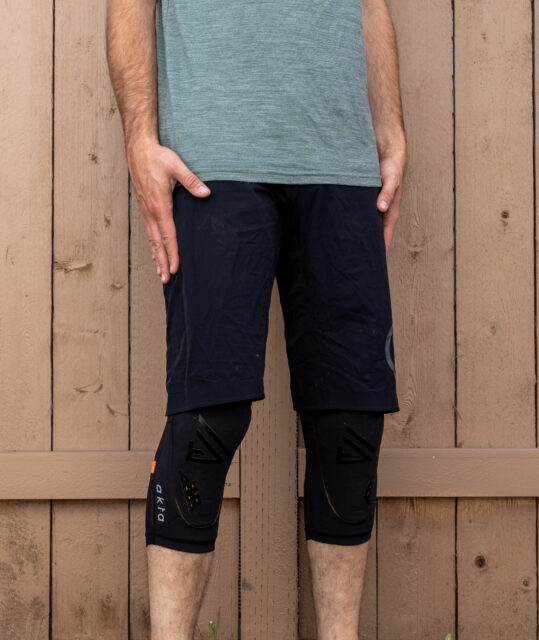
For protection, the Akta Trail Knee Pad uses a removable D3O insert (the LP1), plus a little extra sewn-in padding around the periphery of it for extra coverage. The insert is highly perforated and a little firmer under normal conditions than the D3O sheet used in the Fox Enduro Knee Sleeve (see below), but the Akta’s pad is much more pliable than the inserts used in the 7iDP Transiton or Sam Hill. For folks who aren’t familiar with D3O, it’s a non-Newtonian foam material that is fairly soft and pliable when its at rest (though there are different formulations that feel notably different, as we’ll cover in more detail below) but firms up to offer more protection when it’s compressed rapidly, such as in an impact.
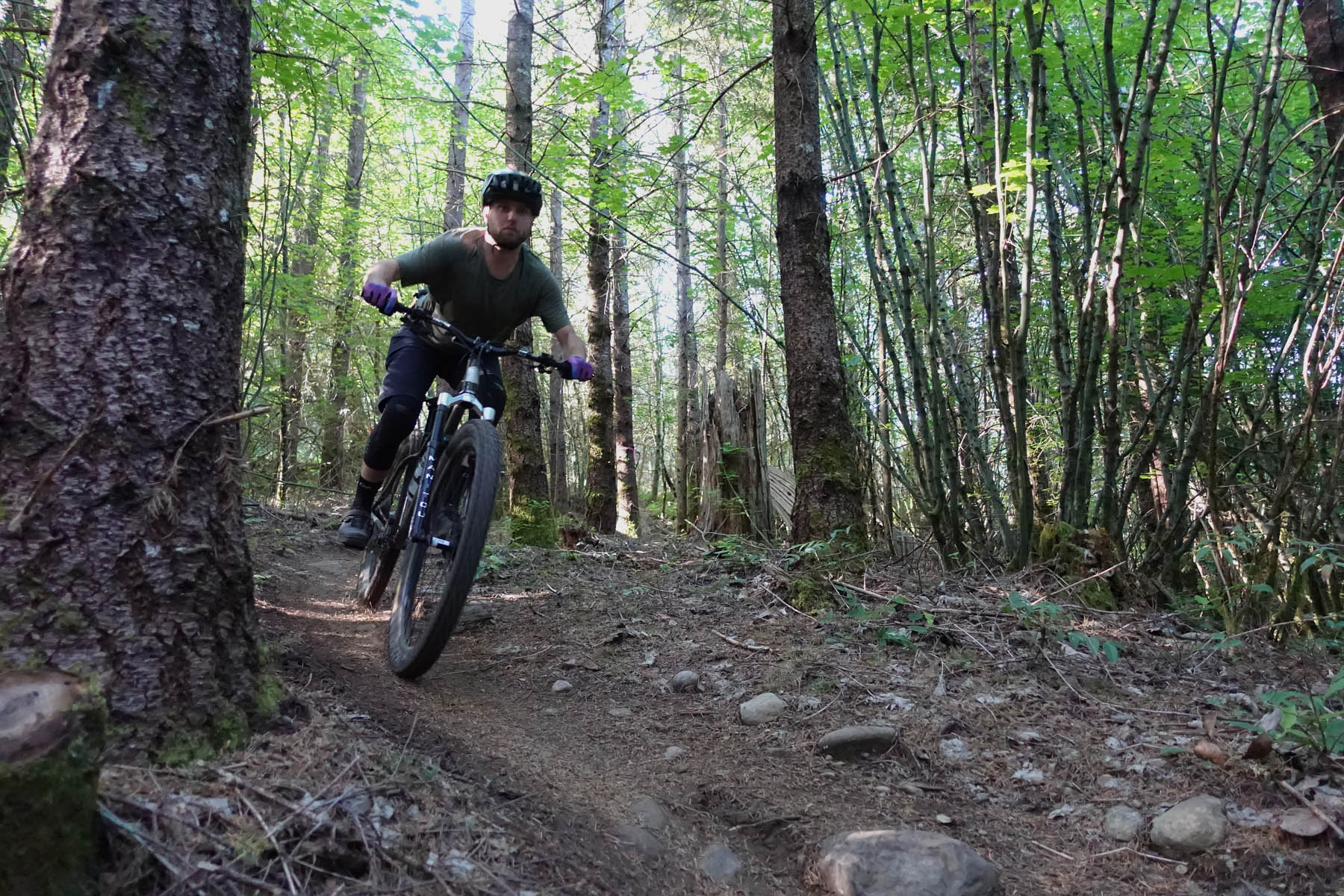
The Akta Traill Knee Pads (and the other pads that use the same insert, of which there are several in this roundup) feel a little bit more cushion-y than the 7iDP Transition and Sam Hill on small to medium impacts while also doing a good job with heavier impacts on harder, smoother surfaces, but probably aren’t quite as protective when landing on sharp rocks in particular. The Akta also breathes a little better than either of the 7iDPs, but not by a big margin. It’s also worth pointing out that, while I tested the Aktas in my typical size Medium and think that’s clearly still the right one for me, they are just a touch on the bigger / looser fitting side of average for a Medium pad. That’s not a bad thing for me, personally — I’m definitely closer to being a Large than I am a Small in most options — but folks who are truly on the brink should probably err on the side of sizing down with these.
Overall, I’m a huge fan of the Akta Trail Knee Pad as an option that’s quite comfortable to pedal in and that offers solid mid-level protection (much more so than the lighter pads here, but less than the heaviest, burliest, most restrictive ones such as the POC Joint VPD 2.0 and 7iDP Project). It does that while also breathing pretty well and overall being relatively secure and not moving around too much, at least on my particular set of knees. If you want a slightly burlier / more protective but less pliable version of a similar concept, the 7iDP Sam Hill is worth a look; for a more ultra-secure take on a largely similar design, check out the Fox Launch Elite. But the Akta both breathes better and, at least for me, is a little more comfortable than both of those, and is a really good middle-of-the-road pad that I can see working well for a lot of folks.
MSRP: $84.95
Reviewer: David Golay (6’, 170 lb / 183 cm, 77.1 kg)
Size tested: Medium
Measured weight per pad: 97 g
Certification: n/a
Despite its name and how gnarly modern “Enduro” tracks are, the Fox Enduro Knee Sleeve is one of the thinnest, lightest, and least protective options here. The “Sleeve” part of the name is definitely accurate, though — the main structure of the pad is a lycra sleeve with a stretchy mesh insert on the upper rear portion, and a tougher (but still quite thin) face fabric over the front padded area for abrasion resistance. There’s an elastic band with some moderate silicone grippers at the upper end of the sleeve to help keep the pad in place, but the lower edge of the sleeve simply uses a folded hem in the lycra material, with no extra grippers or elastic.
The padding comes from a removable sheet of D3O material, which is ultra-pliable and soft but lacks the perforations of some of their more elaborate inserts (which use a significantly stiffer version of the material, in a molded piece with a lot of perforations and ridges to balance ventilation and structure / protection). The result is that the Enduro Knee Sleeve does an especially good job of conforming to the wearer’s knees, and just might be the ticket for folks who are particularly prone to chaffing issues with other knee pads. The downside is that the Enduro Knee Sleeve’s level of protection is quite modest (it’s comparable to the 7iDP Sam Hill Lite, below), and it doesn’t breathe all that well despite being quite thin and light.
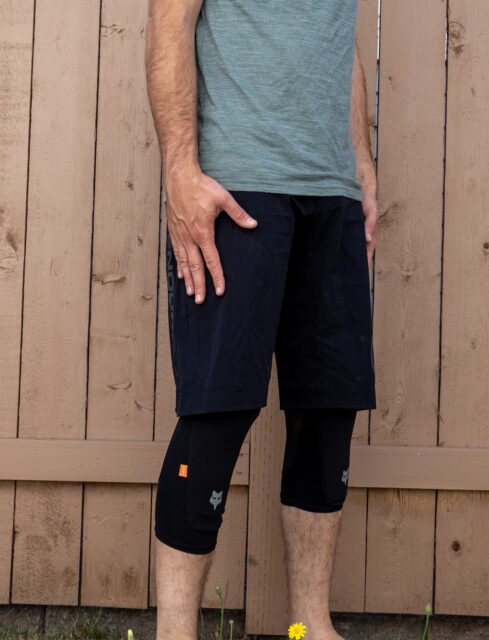
MSRP: $164.95
Reviewer: David Golay (6’, 170 lb / 183 cm, 77.1 kg)
Size tested: Medium
Measured weight per pad: 200 g
Certification: CE EN 1621-1 Level 1
The Launch Elite Knee pad, on the other hand, is a substantially more protective pad than the Enduro Knee Sleeve, with its main padding coming from the same removable D3O LP1 insert used in the Akta Trail Knee Pad (above) and the Race Face Indy Knee (below). It’s a conceptually similar design to the Akta, again with a sleeve-type design with no adjustable straps, but the Launch Elite forgoes the elastic calf strap of the Akta and instead substitutes a much bigger, stiffer upper elastic band with more aggressive silicone grippers. The overall length of the sleeve is about the same between the two, but the upper elastic band on the Launch Elite is significantly tighter and both more secure, but potentially less comfortable than the gentler one on the Akta.
That makes the Launch Elite a great call if you like sleeve-style pads but really don’t like the top of the sleeve to slip down, ever, and I still find the Launch Elite to be quite comfortable. I’m especially fond of wearing them with pants, a situation where hiking the top of a pad back up is considerably more of a chore than it is with shorts, and have quite happily pedaled a lot of big days in the Launch Elite — including the entirety of Trans BC.
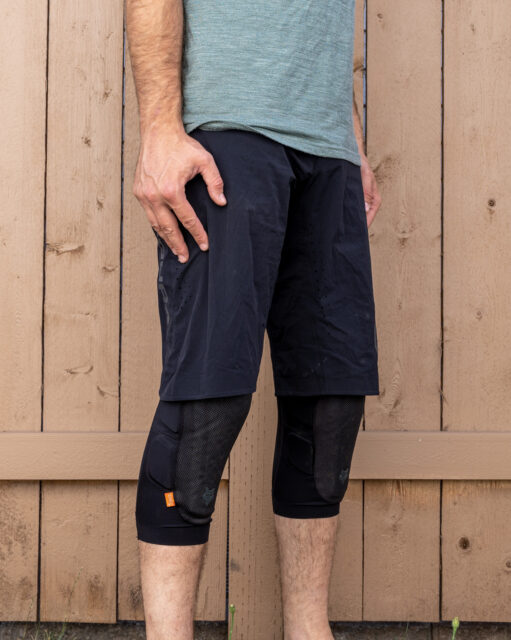
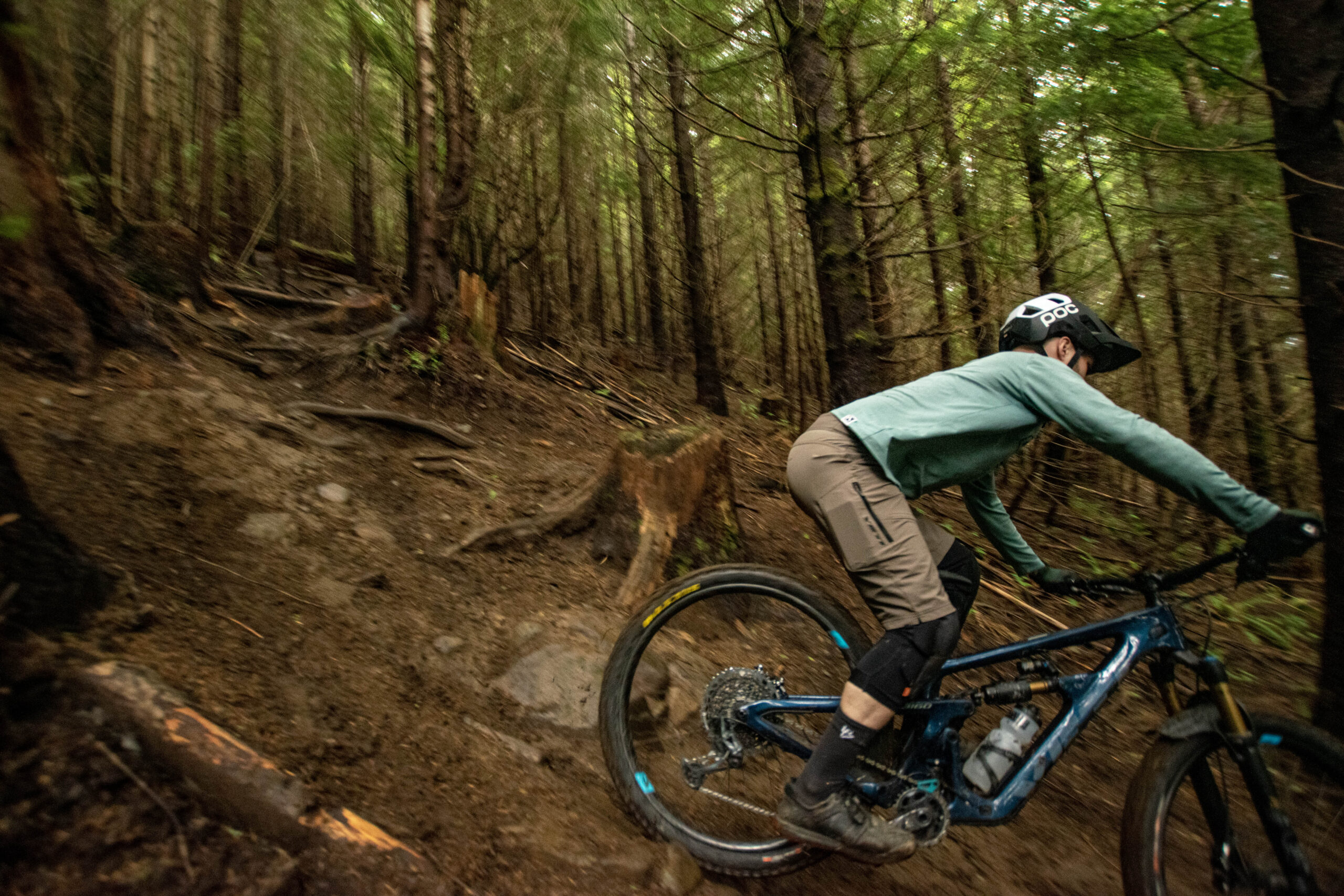
MSRP: $90
Reviewer: David Golay (6’, 170 lb / 183 cm, 77.1 kg)
Size tested: Medium
Measured weight per pad: 167 g
Certification: CE EN 1621-1 Level 1
The Race Face Indy Knee also uses the same removable D3O LP1 insert as the Akta Trail Knee and Fox Launch Elite, so its overall level of protection is very similar to those two, but the Indy separates itself more in terms of fit and form factor. It’s still mostly a sleeve-type pad with a non-adjustable elastic upper band, but the lycra sleeve is considerably shorter than that on most other pads of that form factor (e.g., the Akta and Launch Elite, and especially the 7iDP Transition and Sam Hill). The Indy features an adjustable calf strap (with a similar placement and intent to the non-adjustable one on the Akta). At the top of the sleeve, the Indy uses a modest elastic band and silicone gripper, but both are quite a bit less substantial than the Akta Trail or (especially) the Fox Launch Elite; the Indy is more like a much shorter 7iDP Transition (see below) in that regard.
All that adds up to a pad that offers solid protection and breathes pretty well relative to that level of protection, but isn’t quite as secure as some of the options here that extend farther up the thigh, especially when you hit the ground and slide, which has a tendency to pull pads down. That tradeoff is likely to be a good one for some folks who don’t like super long sleeves that go way up the thigh. As someone on the taller, thinner end of the spectrum, the longer sleeve-style pads work really well for me, but I can readily imagine how that would be different for folks with different proportions.
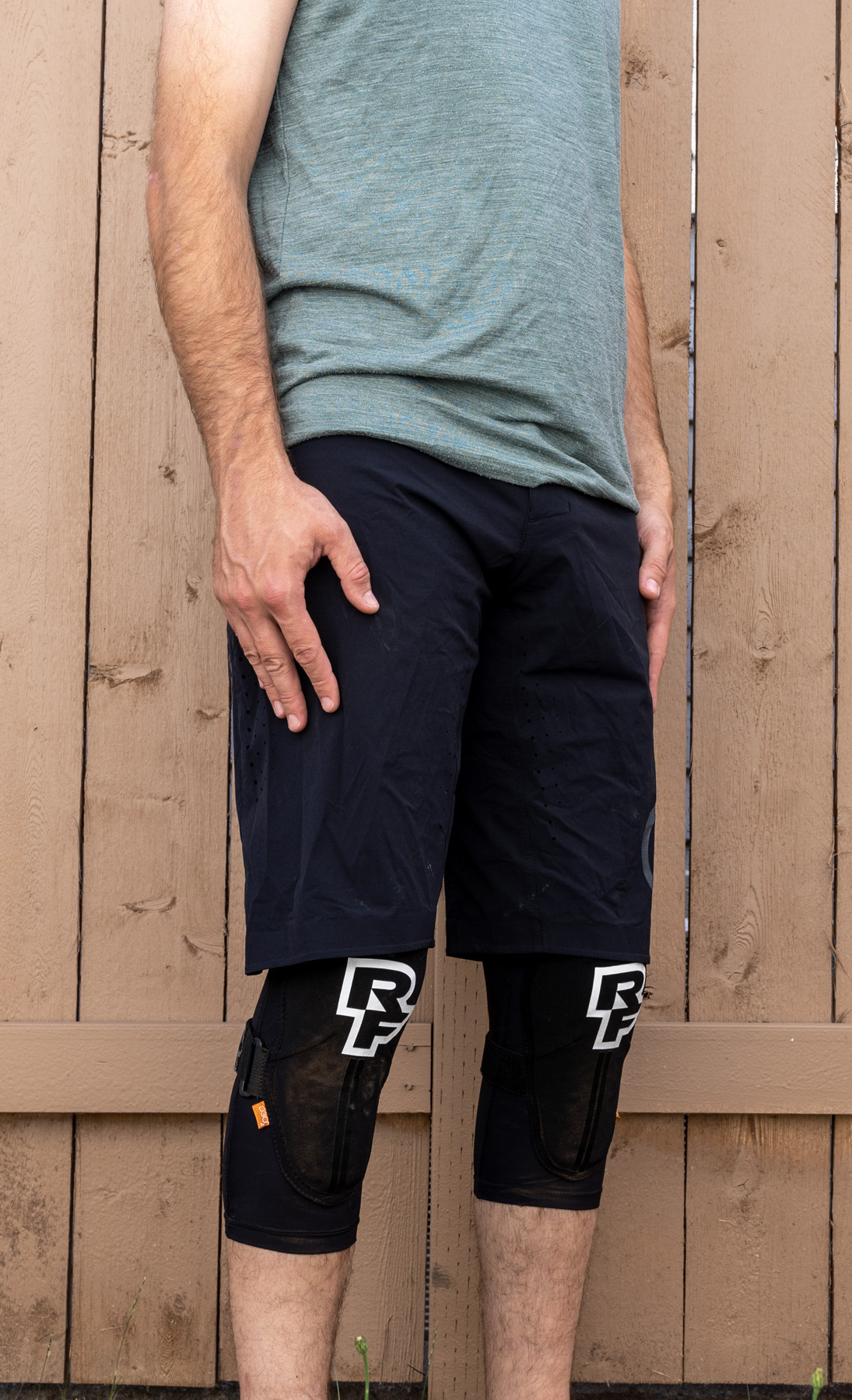
MSRP: $100
Reviewer: David Golay (6’, 170 lb / 183 cm, 77.1 kg)
Size tested: Medium
Measured weight per pad: 141 g
Certification: CE EN 1621-1 Level 1
The Race Face Covert is yet another sleeve-style pad with a removable D3O insert for protection, but the insert used is quite different from the LP1 version used in a whole bunch of the pads here, and the feel and performance of the Covert are quite distinct as a result.
The “Ghost” insert in the Covert uses a mostly-flat piece of D3O material molded into a series of mostly-separate triangles, attached to a slightly-stretchy laminated backing. The result is a very flexible segmented insert, despite the version of D3O used to make it being quite firm (even when it’s not being compressed); it’s just relying on all the voids for that flexibility, and the remaining bits of material need to be firm, given how open the pattern is.
The rest of the pad is a fairly-conventional, lightly-stretchy sleeve with modest silicone grippers at the top and bottom. Though the materials look a bit different (the Covert uses a lot of a 3D-knit waffle-type mesh, rather than more typical lycra), the result is actually quite a bit like a version of the 7iDP Transition that doesn’t extend as far up the thigh, at least in terms of the sleeve itself. The insert, though, feels pretty different from most of the other options here. On the plus side, it’s very well perforated and allows a ton of air flow through the front of the pad, resulting in one of the cooler, more breathable options here.
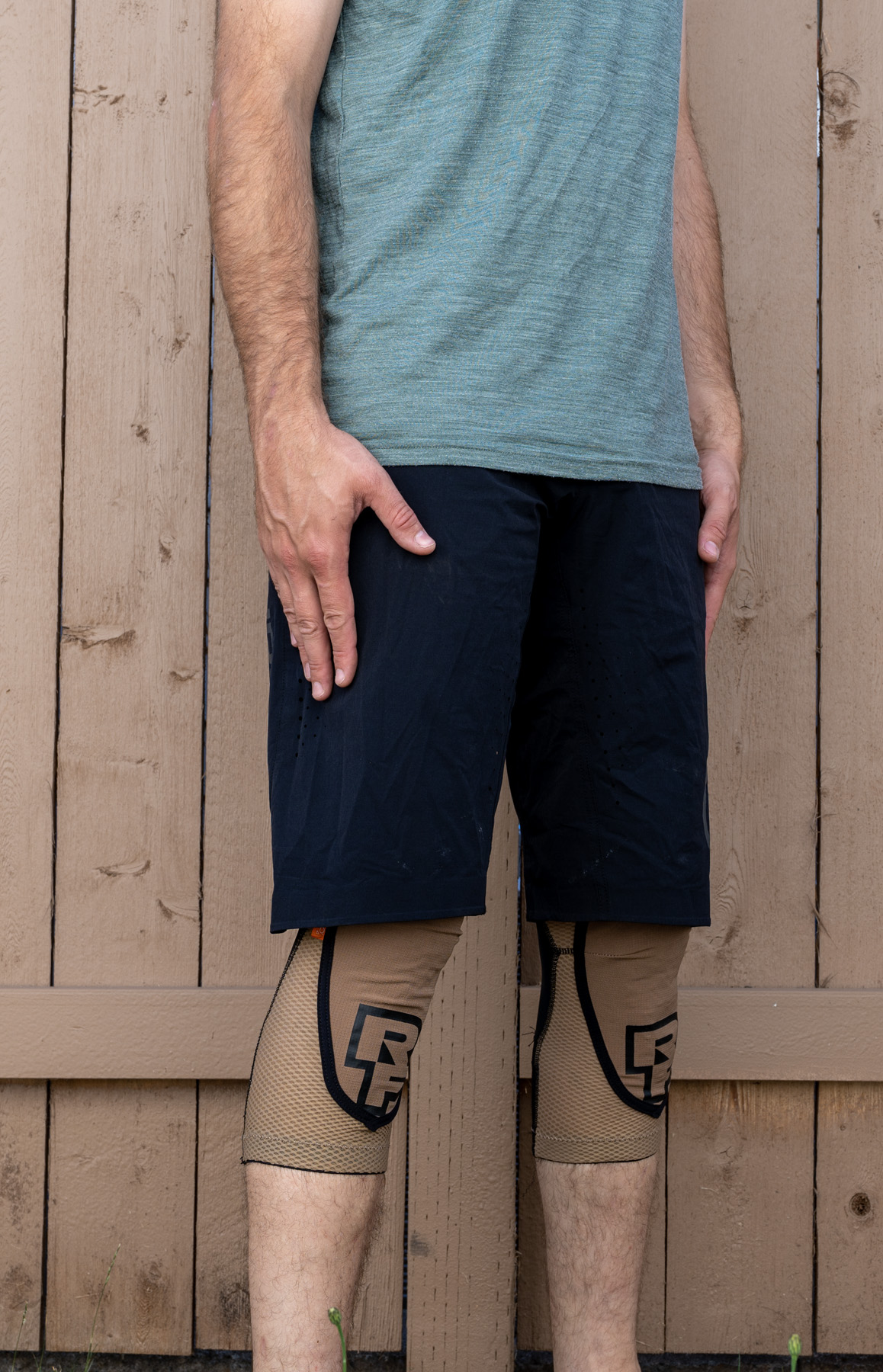
The downside is that, while the insert is pretty flexible overall, the individual little triangles that comprise it are quite firm, and the Covert isn’t very protective when you’re landing on smaller, pointier bits of ground. It fares a lot better on smoother, flatter surfaces, but is still generally one of the lighter, thinner, less-protective options here.
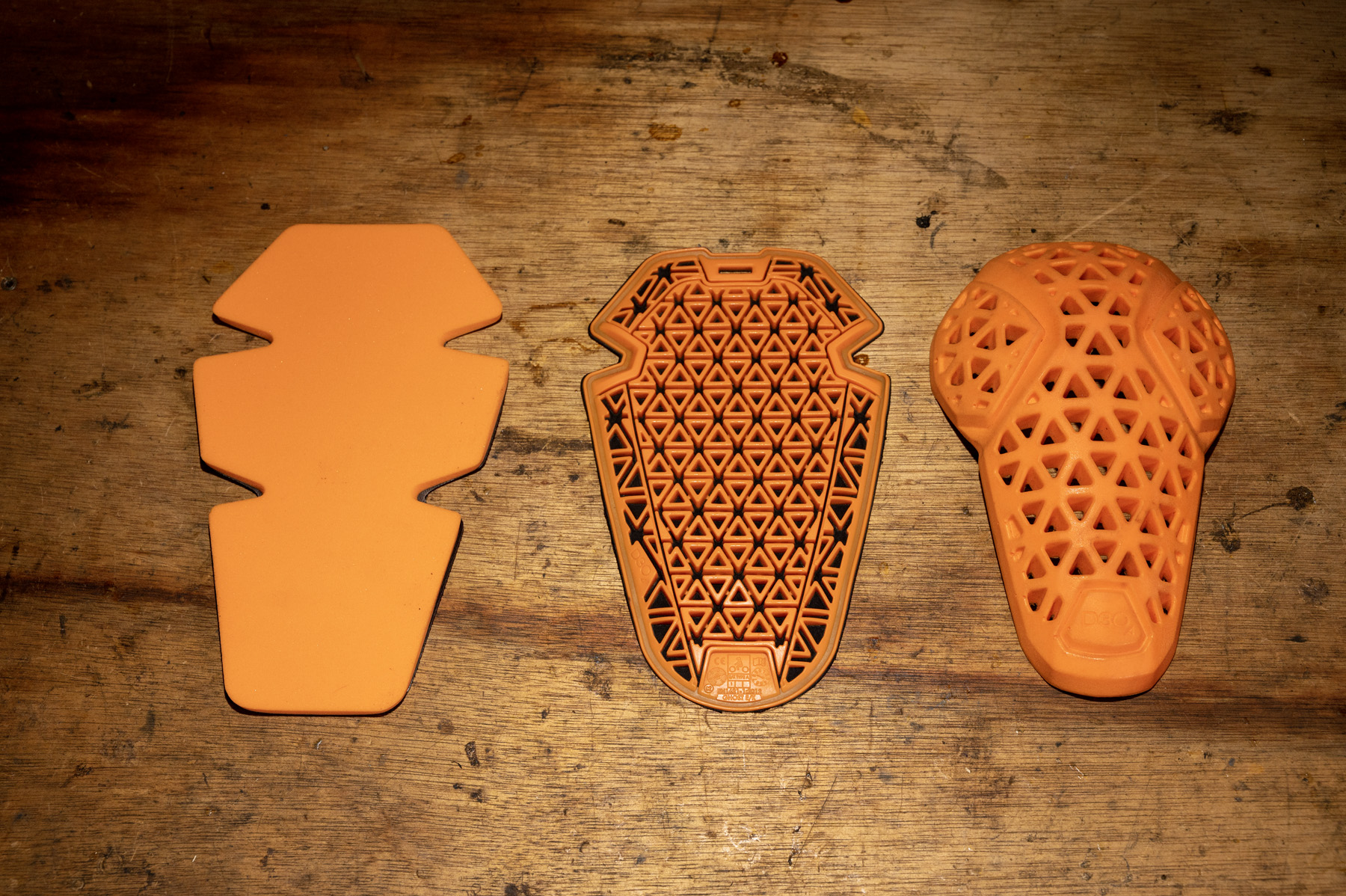
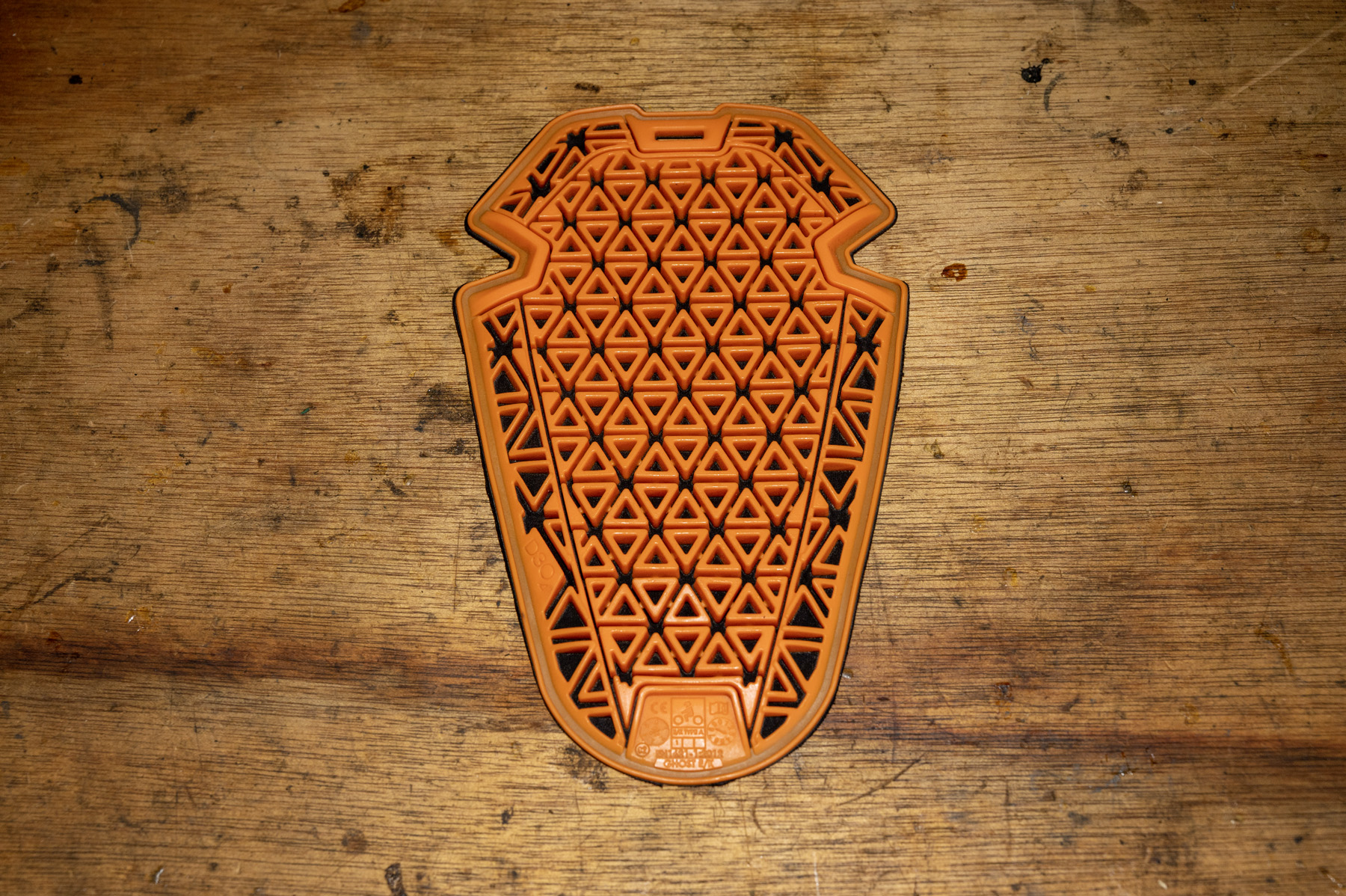
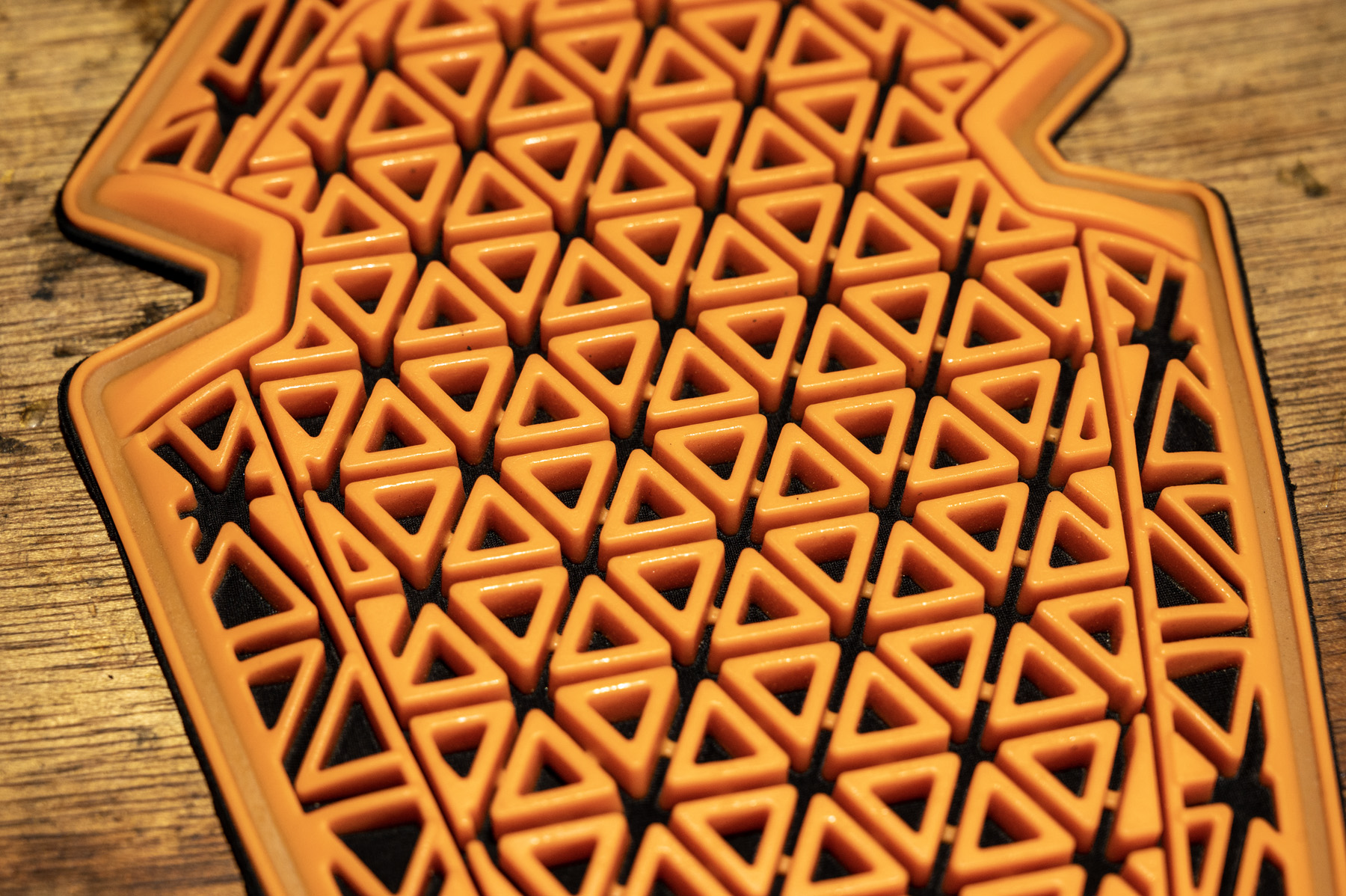
At least on my knees, the insert also feels quite tight over the knee cap, I think in large part because the Covert pad (unlike Race Face’s Indy) runs rather small for a Medium. I’ve tried on (but not ridden in) a Large Covert, which is a bigger step up in sizing than I’d really want to make. So it’s not like they run a full size smaller or anything, but at least for me, personally, the Covert simply doesn’t fit all that well. Of course, your proportions are almost certainly different from mine, and your mileage may vary.
If it fits your legs better than it happens to on mine, the Covert feels like a really promising option for a knee pad that’s generally on the lighter / more breathable end of the spectrum, but is a step up from stuff like the 7iDP Sam Hill Lite and Fox Enduro Sleeve in terms of protection (again, it’s well short of a lot of the burlier options here, though). It wouldn’t be my first choice if you’re liable to land on a bunch of pointy rocks, in particular, but if the fit works for you and you prioritize breathability above outright protection, they’re worth a look.
MSRP: $74.99
Reviewer: David Golay (6’, 170 lb / 183 cm, 77.1 kg)
Size tested: Medium
Measured weight per pad: 143 g
Certification: CE EN 1621 Level 2
I’ve got a couple of friends who swear by the 7iDP Transition as a knee pad that strikes a nice middle ground between all-day pedaling comfort and still being reasonably protective; having now tried them for myself, I can understand why. As with most of 7iDP’s pads, the Transition is based around what they call a “compression fit, slip-on” design, and that’s a pretty good description. The main structure of the pad is essentially a compression sleeve made out of a mix of spandex and a stretchy mesh panel that runs up the back of the leg, with a deeply contoured foam knee cap, covered in a much burlier fabric than the comparatively light materials used for the bulk of the sleeve. Silicone grippers at the top and bottom of the sleeve help keep the Transition in place. The padded knee cap is also removable to make the pads easier to wash.
The key to the Transition’s success, for me, is just how high up the thigh the sock goes, placing the silicone gripper mid-thigh and well away from the moving parts of the knee. And that does a really good job of both stopping the pads from sliding down as I pedal, and helping to avoid chaffing since there’s far less movement underneath the grippers as there tends to be on pads that position them closer to the knee.
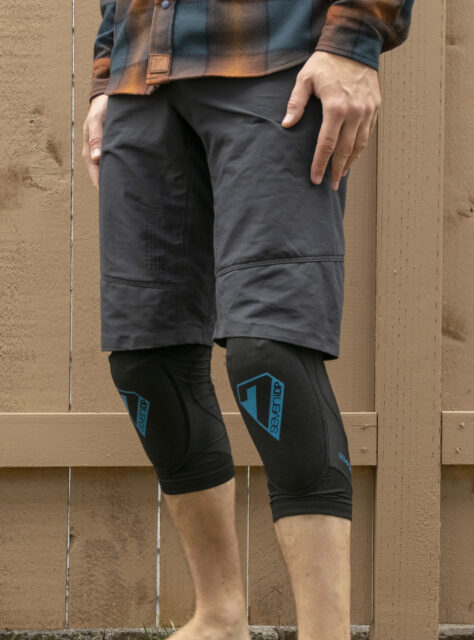
That said, the Transition would fit me better if the padded knee cup was a little bit wider and/or less deep. The sleeve portion of the pad fits great and feels true to size, but the cup feels like it ends up perched on top of my knee cap instead of wrapping cleanly around it and can shift side to side slightly as a result. I haven’t had any notable chaffing issues as a result, and it’s not like the pad is shifting far enough to leave my knee exposed or anything, but it could be more stable. The movement is more mildly annoying than it is a serious problem, and if I hadn’t also tried the 7iDP Sam Hill (up next) I’d probably be singing the praises of the Transition more strongly. They’re still really good knee pads, but I’ve just found an even better (at least for me) version in the Sam Hill (below).
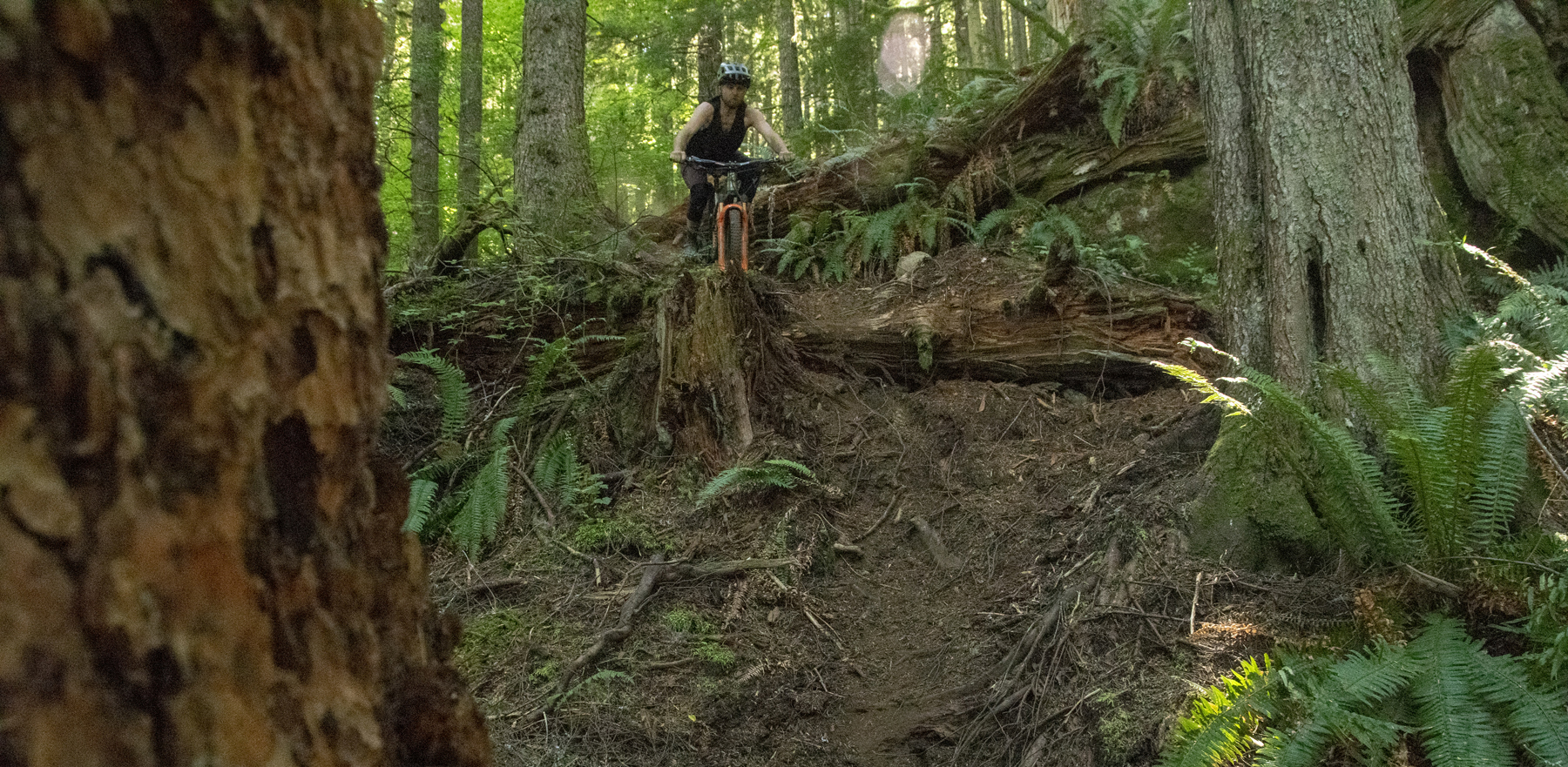
In terms of protection level, the Transition feels like a middle-of-the-road option for impacts to the center of the knee but doesn’t have much padding that wraps around the sides. Of course, that helps somewhat with breathability, and despite covering a larger-than-average portion of the leg, the Transition is fairly cool for its level of protection. It’s no substitute for a full-on DH pad, and there are lighter, more breathable options here, but the Transition is a nice middle-ground option that I’ve found to be comfortable to pedal in while still offering solid protection.
7iDP also offers a longer version of the Transition with more complete shin coverage, called the Transition Knee/Shin, which we haven’t tested but looks like essentially the same design, but extended most of the length of the shin.
MSRP: $94.99
Reviewer: David Golay (6’, 170 lb / 183 cm, 77.1 kg)
Size tested: Medium
Measured weight per pad: 168 g
Certification: CE EN 1621 Level 2
The 7iDP Sam Hill uses a sleeve system that’s very similar to that of the Transition (above), but with some extra padding sewn in around the removable foam knee cup, and though it uses the exact same knee cup insert as the Transition, that extra padding helps stabilize the knee cup and makes the Sam Hill pad far less prone to twisting side to side on my knees than the Transition.
And so while I like the Transition, that little tweak makes the Sam Hill a significant improvement in my book. The extra padding adds a tiny bit of weight and compromises breathability very slightly, but those differences are minor and the added stability of the knee cup more than makes up for it from a comfort perspective for me.
The added padding also makes the Sam Hill very slightly more protective than the Transition around the periphery of the knee area, but they’re not far off from each other in that (and most other) respects. They’re overall very similar designs.
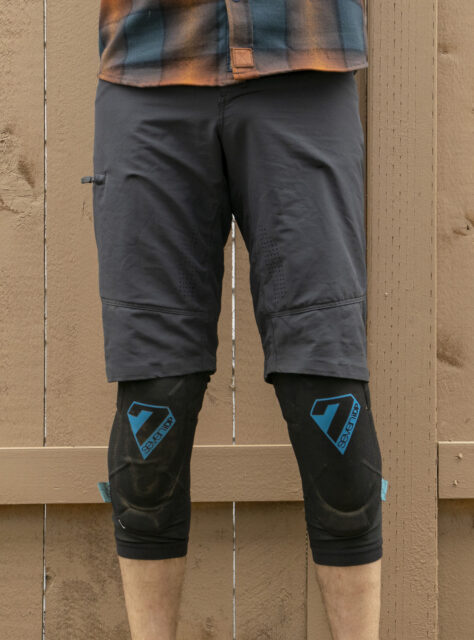
All of that has made the Sam Hill my go-to pad for longer days in the saddle where I’m still riding trails that are burly enough to merit a fairly protective knee pad. And in that role it’s great. I wore the Sam Hill pads on a 50+ mile, 11,000+ foot day recently and happily kept them on for the whole ride without issue. They’re quite impressive.
MSRP: $84.99
Reviewer: David Golay (6’, 170 lb / 183 cm, 77.1 kg)
Size tested: Medium
Measured weight per pad: 97 g
Certification: CE EN 1621 Level 1
Unsurprisingly, the 7iDP Sam Hill Lite is something like a slimmed-down version of the regular Sam Hill knee pad, but if anything that maybe undersells just how pared down the Sam Hill Lite is. Like the regular Sam Hill pad, the Lite version uses a compression sleeve with silicone grippers to hold the pad up and a removable (for cleaning) foam insert over the knee cap, but the Sam Hill Lite uses a shorter, more minimalist sleeve and a much thinner, more flexible, and lighter pad that breathes great and is super cool and comfortable but is also quite bare-bones (pun not intended) in its level of protection.
So I’ve been wearing the Sam Hill Lite on mellower rides and/or hotter days when I’m more inclined to roll the dice on the level of protection in exchange for something cooler and more breathable, and if you’ve got reasonable expectations for what that tradeoff entails, the Sam Hill Lite is a great option. They’re definitely light and breathable first-and-foremost, while still offering a little protection, but they’re the lightest, least-protective pad in this roundup by some margin.
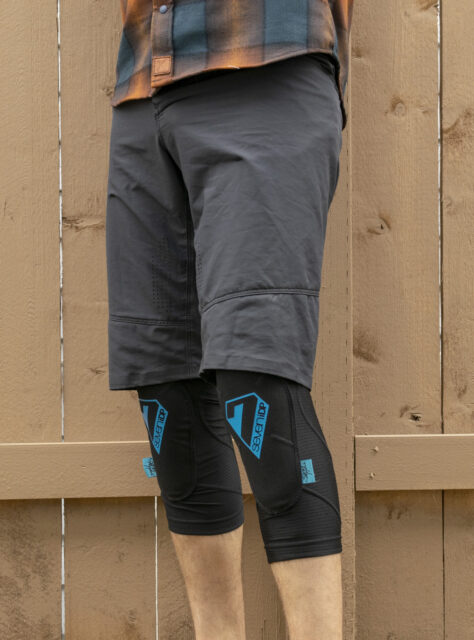
Despite their lightweight construction, the Sam Hill Lite pads have held up fine to a couple of minor crashes and stayed put reasonably well during them, but they’re definitely more of a “take the edge off” kind of pad, rather than a highly protective one. Given how light and breathable they are, that tradeoff feels totally fair to me, but it’s proof that you can’t really have it all with these things — as in so many cases when it comes to outdoor gear, it’s much more a matter of knowing thyself and making the right compromises for your needs than there being any kind of universally applicable “best” anything.
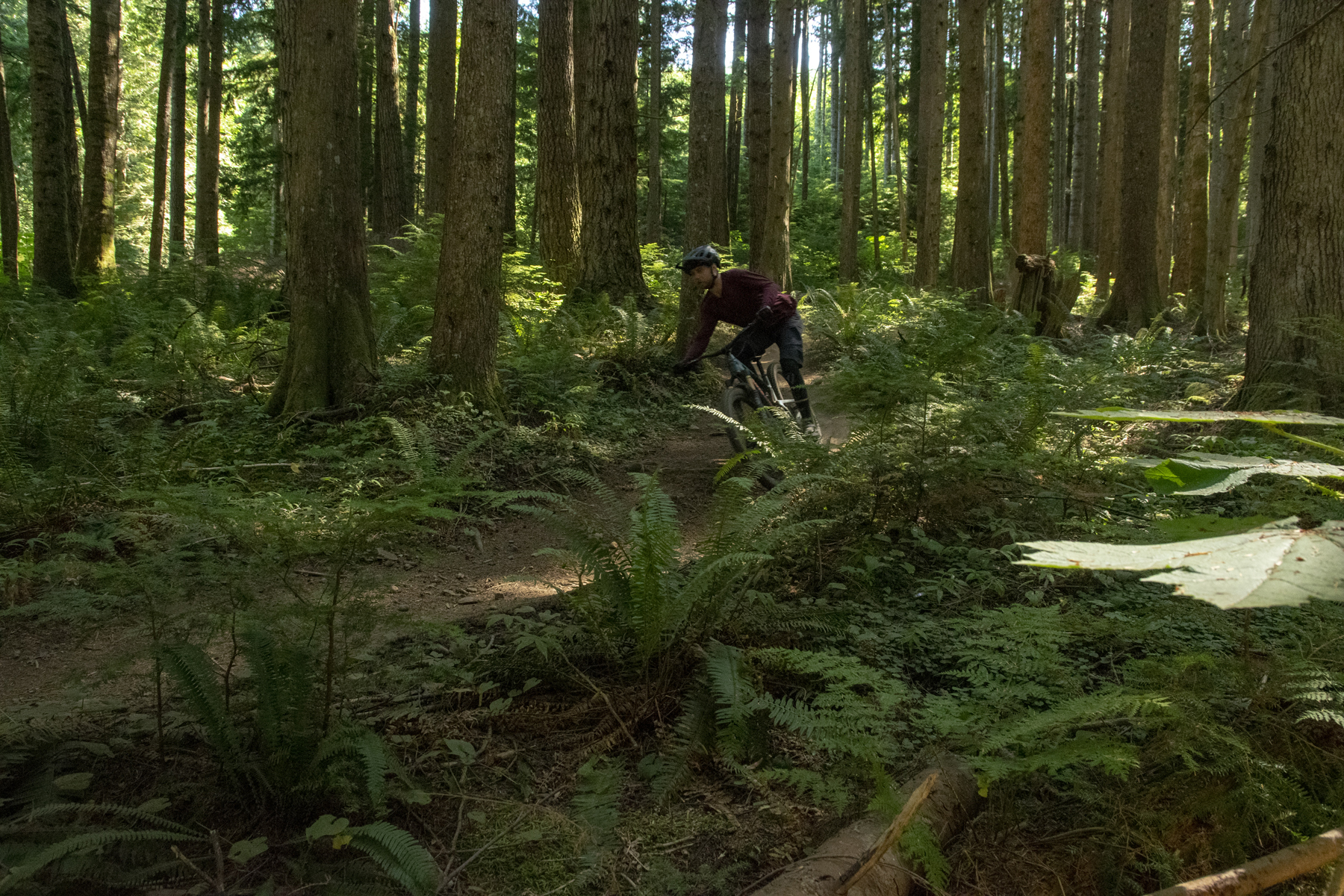
MSRP: $129.99
Reviewer: David Golay (6’, 170 lb / 183 cm, 77.1 kg)
Size tested: Medium
Measured weight per pad: 219 g
Certification: CE EN 1621 Level 2
At the other end of the 7iDP line is the Project knee pad, their burliest, most-protective offering. Think of it as something like a version of the Sam Hill but with thicker, tougher fabric comprising much of the sleeve, an extra semi-flexible plastic cap over the front of the knee, and a pair of symmetric velcro straps to further secure the pad mid-thigh.
As a result, the Project is both more secure and stable than the Sam Hill and also more protective, but is also warmer, less breathable, and not as comfortable to pedal in. I’ve still worn them on some longer days and haven’t had major chaffing issues or anything like that, but they’re on the warm side and definitely are more prone to rubbing than many of the thinner, more flexible pads here.
That said, the outer plastic cover is a nice feature, especially for people who are going to be wearing the Project with shorts, in rockier, harder terrain. Not only does it help dissipate impacts with sharp, pointy objects, but it also slides on rocks and hardpacked dirt much better than the cloth covers on many of the pads here. And I think 7iDP has done a nice job balancing all of that while still having the cover be somewhat flexible to conform with your knee as you pedal.
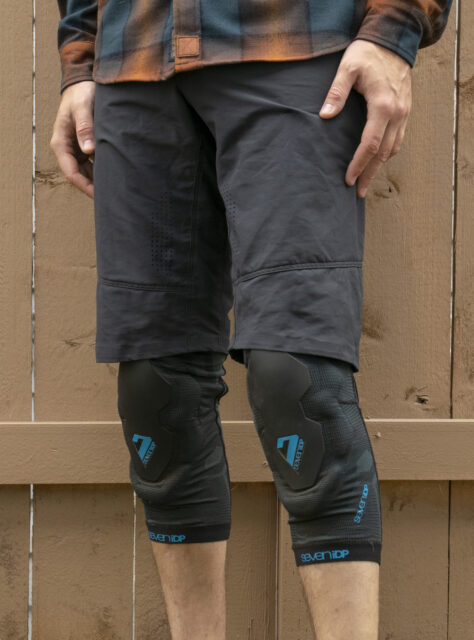
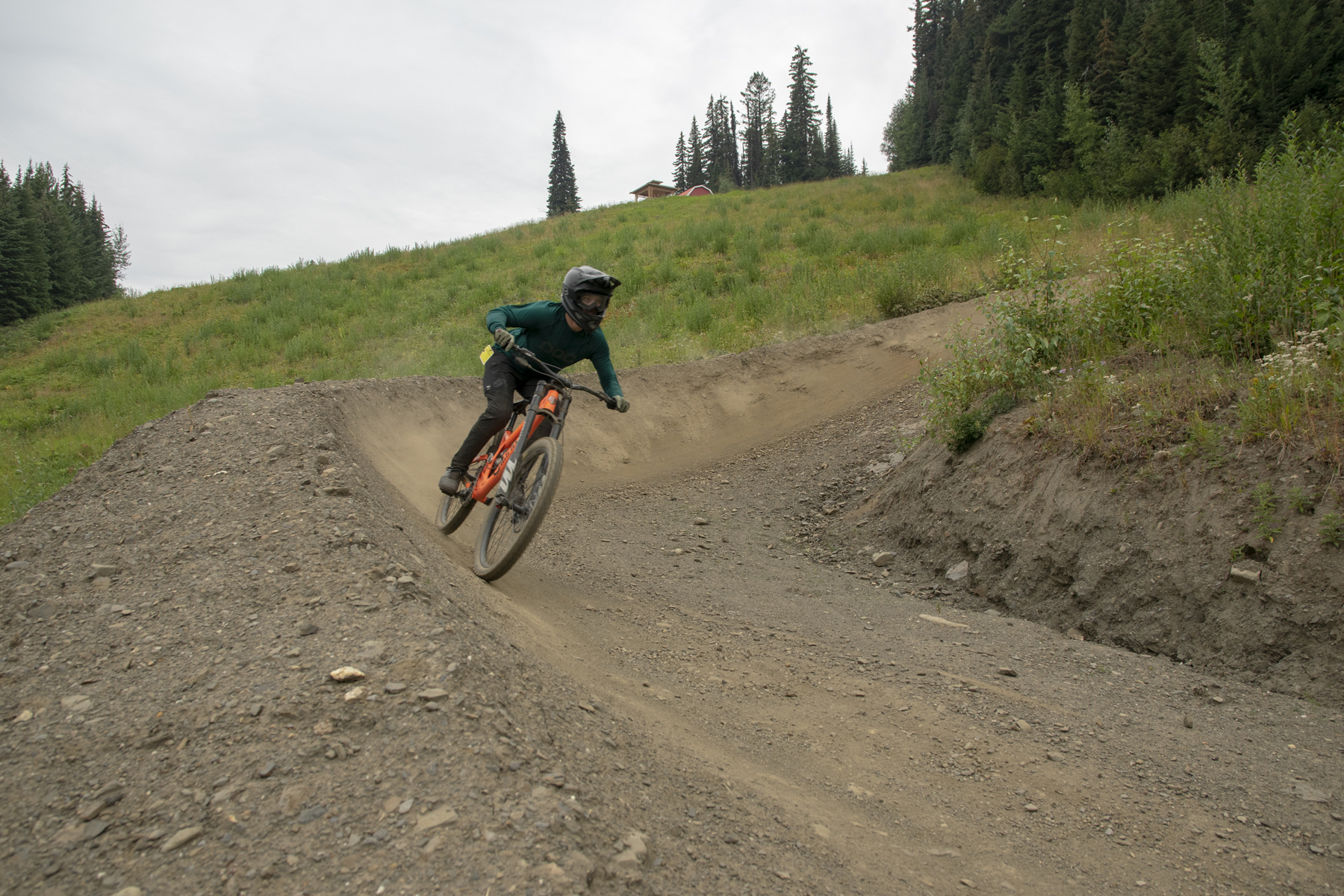
MSRP: $140.00 USD
Reviewer: Zack Henderson (6’, 160 lb / 183 cm, 72.6 kg)
Size tested: Medium
Stated weight per pad: 250 g
Certification: CE EU 2016/425
The Dakine Agent is a relatively heavy pad, but offers an inspiring level of protection and durability that should appeal to folks who favor protection and durability over pedaling performance.
The Agent is billed as a more protective option in Dakine’s lineup, and the very deep knee cup and extensive shin coverage reflect that intention. I found them to fit quite snug in my typical Medium size preference, but they did loosen up a bit over the first few rides. The DK Impact pad material is relatively flexible but firms up a bit when temperatures dip. I found articulation around the knee joint itself to be a bit lacking, and the pads didn’t conform as well to my knee as I would like when my leg was fully extended. The burly material on the front of the pad also does not breathe particularly well, but is impressively durable.
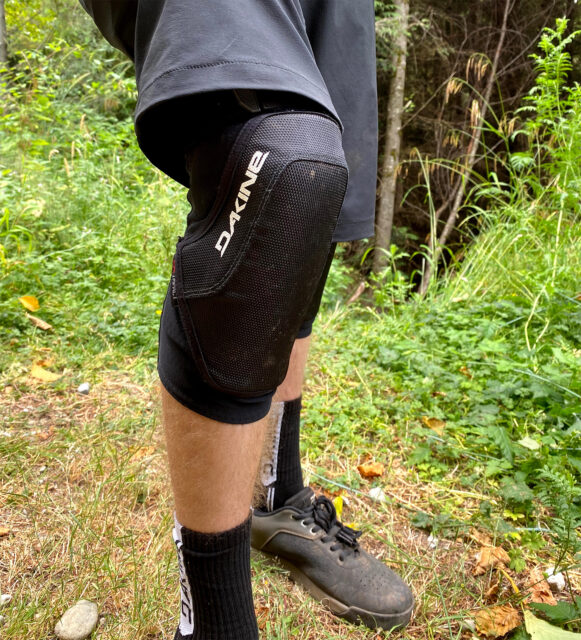
In my mind, these pads are in their element in the bike park, and they disappear nicely in a more aggressive, knees-bent stance while providing huge amounts of coverage. I had a couple of small crashes during the test period and the pads didn’t budge or show any signs of wear, and they give the impression that they could survive a couple of seasons of abuse without issue. Enduro-oriented riders who want something protective would likely be well served by these pads as well, provided that you don’t mind pulling them down around your ankles to prevent overly sweaty knees on the way up.
David: I’ve also tried the Agent a bit, and essentially agree with Zack’s assessment: the Agent pad is burly, protective, and does a good job staying put in crashes, but is hot and not very comfortable to pedal in. They also chafed the back of my knees pretty badly when I left them on the for the climbs. If you’re fine with sliding them down around your ankles to pedal, the Agent is worth considering, but I’d recommend that most folks who want a knee pad to actually pedal in look elsewhere.
MSRP: $109.99
Reviewer: Luke Koppa (5’8”, 155 lbs / 173 cm, 70 kg)
Size tested: S/M
Measured weight per pad: 200 g
Certification: CE EN 1621 Level 1
The MT500 Lite is one of Endura’s most protective knee pads, but it’s still built with pedaling in mind. Most of its protection comes from its fairly large and perforated D30 insert, which is pretty soft and pliable but will stiffen when subjected to an impact. The “Lite” version we tested covers that D30 insert with a stretch fabric and some mesh, with the goal of optimizing breathability; there’s also the MT500 Hard Shell pad, which features a more rugged build with a plastic cap over the pad to add protection and reduce friction when sliding during a fall.
I think the MT500 Lite hits a nice sweet spot of protection and pedaling comfort for a lot of folks. It’s quite breathable but offers notably more protection and coverage than the most minimal options, such as the 7iDP Sam Hill Lite. The MT500 Lite relies on a combination of silicone cuff grippers and upper and lower velcro straps to stay secure, and I’ve found them to be good at their job. I still can’t pedal for very long in it without some chafing, but I seem to be more sensitive to this than most other folks, and the MT500 Lite doesn’t move / shift as much during pedaling as the POC Oseus VPD or Scott Soldier 2. The MT500 Lite also features some PU foam padding on the inside and outside of the main pad, which I always appreciate when my bike and I are knocking around through a rock garden.
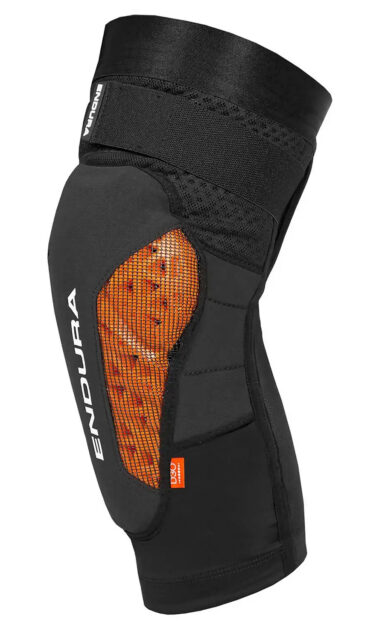
MSRP: $104.99
Reviewer: Luke Koppa (5’8”, 155 lbs / 173 cm, 70 kg)
Size tested: Medium
Measured weight per pad: 169 g
Certification: CE EN 1621 Level 1
I’d put Ion’s K-Lite pad in a similar class as the Endura MT500 Lite; the K-Lite is designed for Enduro racing and consequently straddles the line between pedal-oriented and protection-focused pads.
Like the MT500 Lite, the K-Lite pad uses both silicone grippers and dual velcro straps to dial in the fit, and I’ve found it to be reliably secure and comfortable. I still get some chafing during extended pedals, and the K-Lite runs a bit hotter than the MT500 Lite. Overall, though, the K-Lite seems adequately breathable and comfortable to be a solid choice for long climbs that get you to the top of fairly consequential descents, where a super minimal option like the Sam Hill Lite might seem a bit under-protective but a DH-specific model would be excessive.
The K-Lite features a large, flexible, perforated “K-L1 Lite” pad that handles most of the protection duties, but also includes multiple EVA foam pads on either side of the knee. It also covers the main pad with an abrasion-resistant material that bridges the gap between a typical fabric covering and a full hard-shell plastic. The main sleeve fabric is also reportedly reinforced with Aramid fibers, which should boost durability; while I haven’t crashed in it (yet), the K-Lite is holding up great so far.
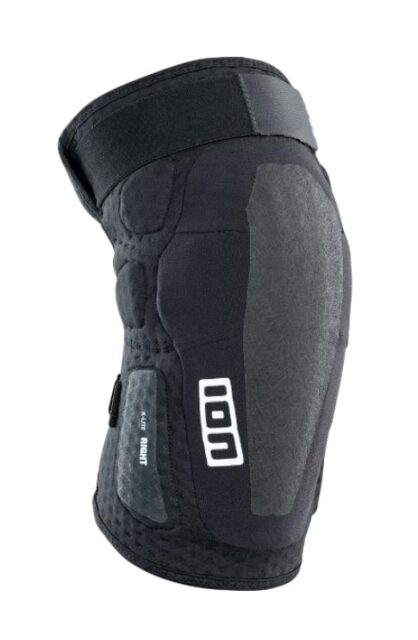
David: I’ve also spent some time in the K-Lite, and the thing that stood out most to me was how secure the fit felt, for what is a pad that’s meant to balance protection with pedaling comfort. I think part of that is that the K-Lite runs a hair on the smaller side of average for a Medium pad, and is just a bit tighter than many of the other options here on my legs; its strap system is also really well done and keeps the pads in place especially well, both when pedaling and when hitting the ground.
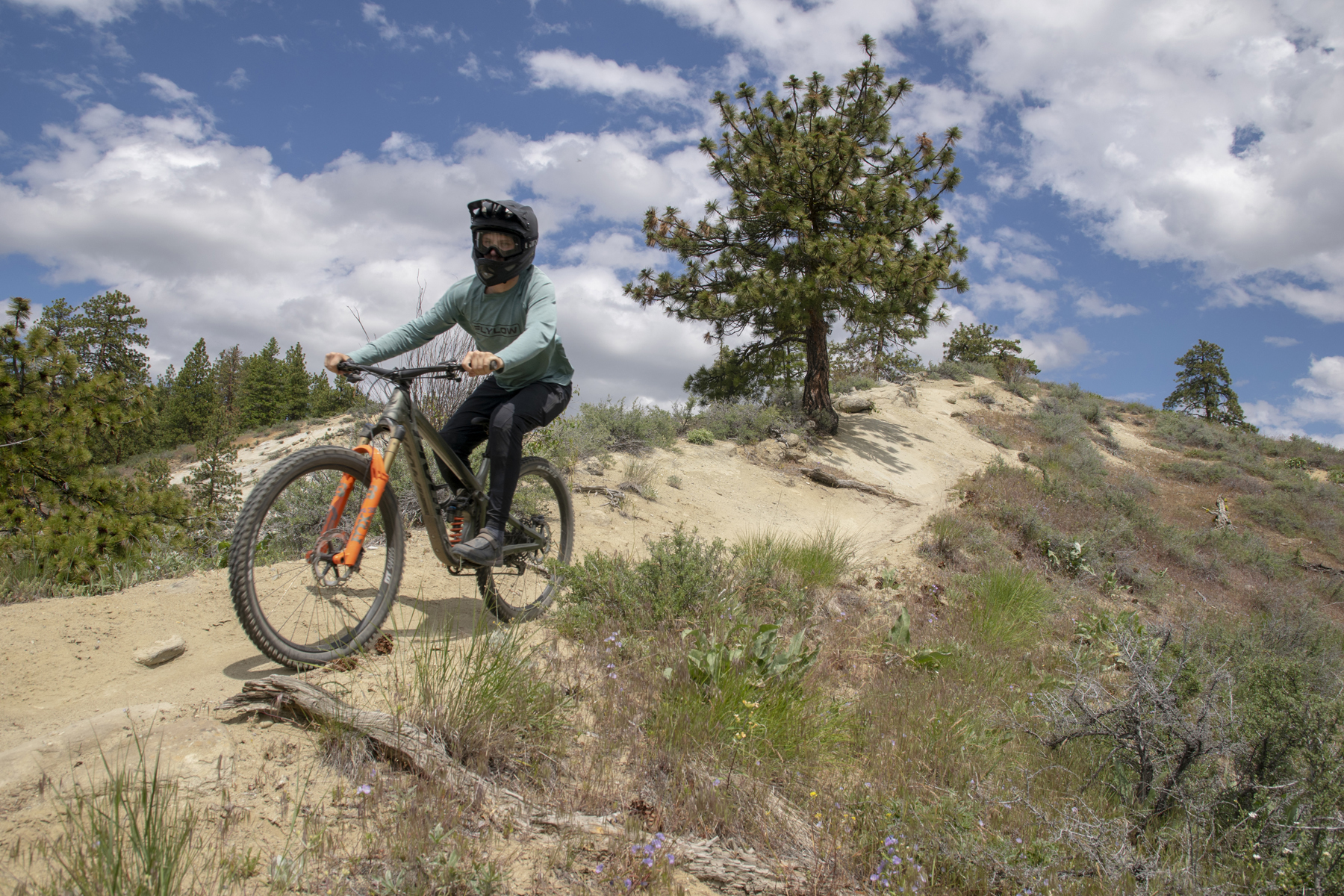
MSRP: $99.90 USD
Reviewer: Zack Henderson (6’, 160 lb / 183 cm, 72.6 kg)
Size tested: Medium
Measured weight per pad: 146 g
Certification: CE EN 1621 Level 1
The IXS Flow Evo+ is a very common sight on the trails here in the Pacific Northwest, and it’s an unobtrusive option that still offers better protection than some more lightweight pads aimed at the XC/trail crowd.
The Flow Evo+ pads breathe remarkably well compared to some other options, largely thanks to the stretchy AeroMesh material around the back of the knee. The knee cup offers relatively more minimalist coverage via a removable non-Newtonian pad made of what IXS calls Xmatter, and I’ve found the pad material to remain impressively pliable in colder weather. The pads don’t have any protection around the sides of the knee, favoring breathability over extensive coverage.
The price of their light weight and breathability is that the coverage is quite short — both in terms of how far the pads go up the thigh, as well as how far they extend down the shin. This does lead to some of the dreaded shorts gap where the hem of my shorts often sit above the upper cuff of the pad — unfashionable, but only an issue while seated and pedaling. The single calf strap is a somewhat unique approach to securing the pads, but it works incredibly well to keep the pads in place and goes unnoticed while riding. I wouldn’t choose the Flow Evo+ as my only pad, but they’re a great option for longer or lower consequence rides where they provide better-than-average protection for their weight and breathability.
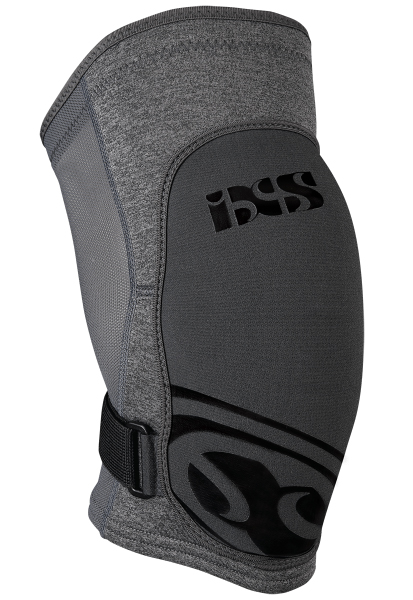
MSRP: $119.99 (Currently on sale for $89.99)
Reviewer: Luke Koppa (5’8”, 155 lbs / 173 cm, 70 kg)
Size tested: Medium
Measured weight per pad: 183 g
Certification: CE EN 1621 Level 1
Long story short: the AirFlex Hybrid is the only pad I’ve used that I can comfortably pedal in for a full day.
The AirFlex Hybrid blurs the lines between really minimal pads like the 7iDP Sam Hill Lite and more substantial Enduro pads like the Endura MT500 Lite and Ion K-Lite. The AirFlex Hybrid is primarily composed of a knit sleeve that feels more sock-like than Lycra-tight, which I think is part of why I don’t experience chafing issues with it. This pad still relies on silicone grippers to stay secure, but I think the combo of its sleeve being quite long and its fabric being highly stretchy (but not extremely tight) prevents the silicone from being pulled up and down my leg while pedaling. Despite the AirFlex Hybrid’s fabric being fairly thick, it’s still quite breathable and the back of the pad is mostly open, which adds to its ventilation.
The AirFlex Hybrid’s pad is a bit smaller than that of the Endura MT500 Lite and Ion K-Lite, but not by a big margin, and the AirFlex still offers just a bit of side padding. The AirFlex Hybrid’s main pad is covered with two small hard-shell pieces for reduced friction when sliding; while I’m much more confident in a traditional hard-shell pad for frequent crashes on hard terrain, it’s a nice touch that hasn’t impeded pedaling comfort at all in my experience.
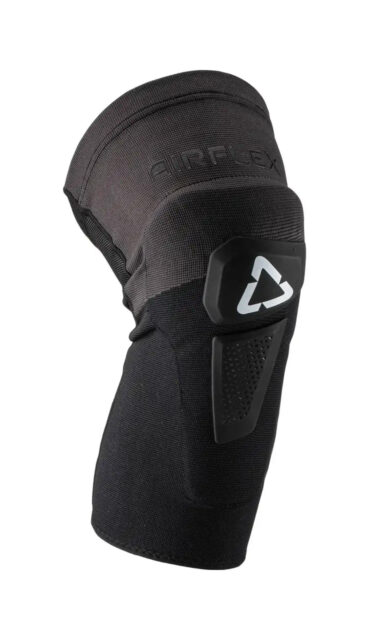
All in all, I’m a massive fan of the AirFlex Hybrid and it’s become my go-to pad for general trail riding. There are more protective options out there, and some of those might still work well for long days of pedaling for certain people. But especially if you’re like me and haven’t found a pad that you can pedal in without chafing but that still meets the EN1621-1, Level 1 standards, the AirFlex Hybrid is worth a close look.
David: Yep, the AirFlex Hybrid is remarkably comfortable to pedal in. The sock sleeve is on the thicker side but it’s super soft and breathes pretty well. The AirFlex Hybrid is on the lighter, less-protective end of the spectrum (though feels beefier that the 7iDP Sam Hill Lite), but if you’re okay making that tradeoff to get a super comfortable pad, they’re a great call.
MSRP: $150
Reviewer: David Golay (6’, 170 lb / 183 cm, 77.1 kg)
Size tested: Medium
Measured weight per pad: 185 g
Certification: CE EN 1621 Level 2
I’ve been a big fan of the POC Joint System VPD for a long time now, and they’re still one of my favorite options for a pad that’s fairly protective but still comfortable to pedal in all day. Like many of the options here, the Joint System VPD pads use a sleeve system without any additional straps to secure themselves, but (especially compared to the 7iDP Transition and Sam Hill, and Troy Lee Stage) use a much shorter elastic sleeve that doesn’t extend nearly as far up the thigh. Despite that, I’ve had no trouble with the silicone gripper at the top of the sleeve chaffing, even on very long rides, and with less of the leg covered by the sleeve, the Joint System VPD allows for better ventilation of the upper leg.
The tradeoff there is that the Joint System VPD isn’t the most secure pad out there, and can definitely get pulled down in some crashes, particularly on harder ground. The upper part of the gripper can also creep down slightly as you pedal, and while the actual pad has tended to stay put nicely on my legs, I do find myself needing to pull the upper part of the sleeve up my leg at the top of a lot of climbs.
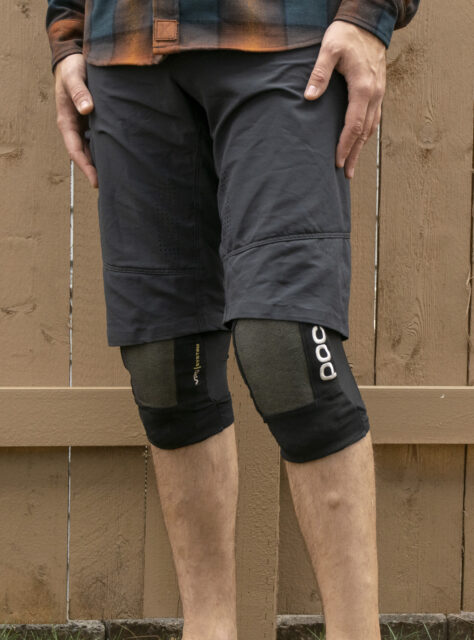
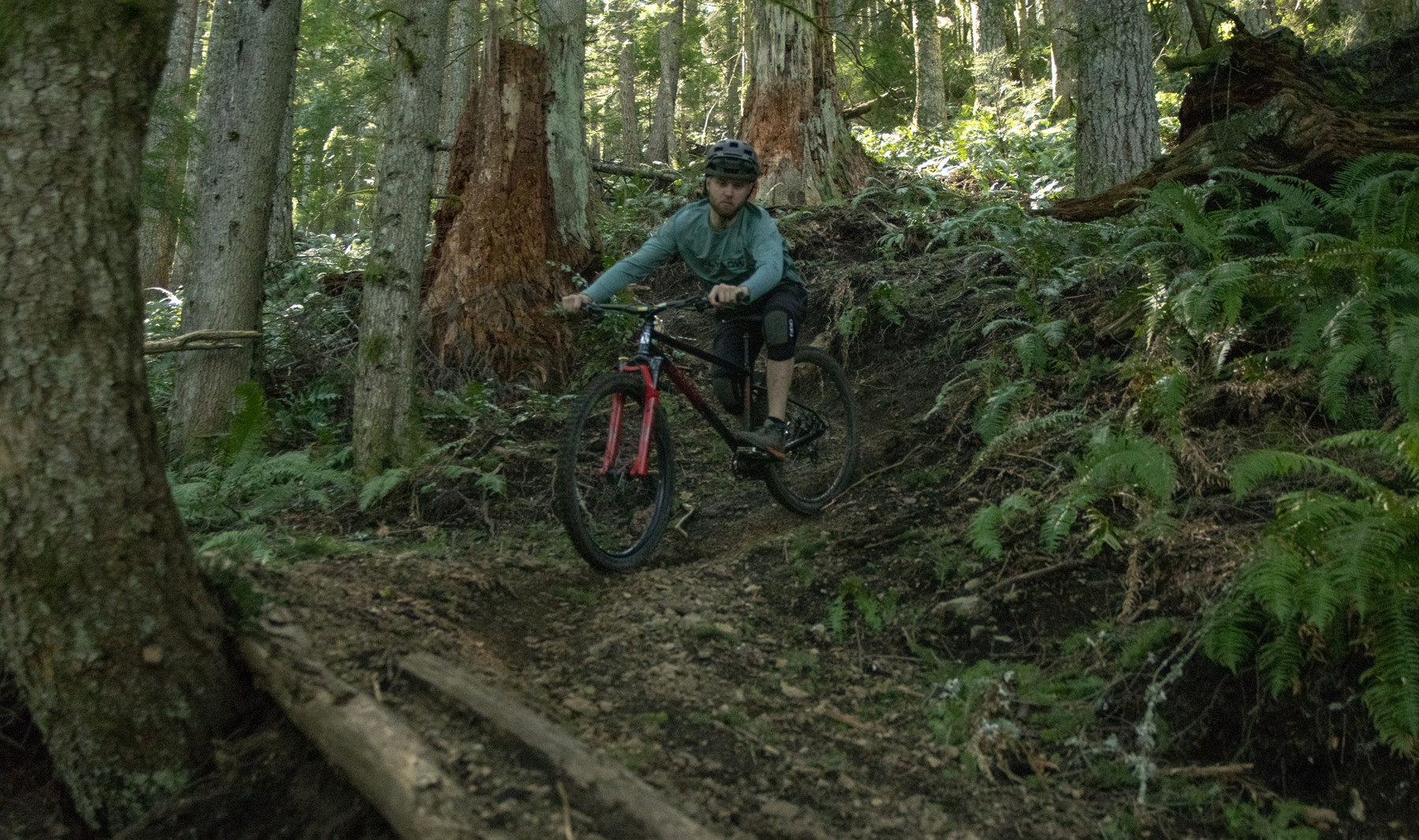
MSRP: $120 (Currently on sale for $60)
Reviewer: David Golay (6’, 170 lb / 183 cm, 77.1 kg)
Size tested: Medium
Measured weight per pad: 281 g
Certification: CE EN 1621 Level 2
The Joint VPD 2.0 has been in POC’s lineup for quite a while now, and it’s still a really good option for folks looking for a highly protective, secure pad for more gravity-oriented riding, and are willing to forgo some breathability and pedaling comfort to get there.
The Joint VPD 2.0 pads are pliable, fit great (at least for me), and do a nice job of conforming around my knees, but the strap arrangement does tend to pinch a little if I’m doing a lot of pedaling in them. They’re fine for shorter laps and are quite comfortable for more mechanized riding where I don’t need to do a ton of pedaling but aren’t particularly light or breathable, and if I’m going for a longer pedal I’d generally prefer something thinner, lighter, and cooler. That said, I haven’t had any major chaffing issues or anything like that in the Joint VPD 2.0; they just feel hot and somewhat restrictive.
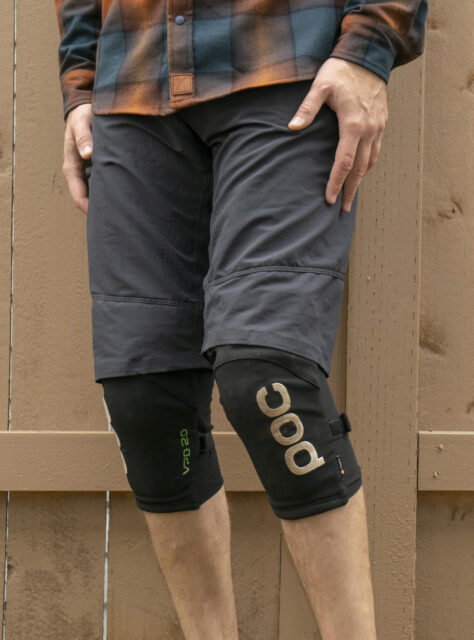
That’s not to say that they run small, though — they’re just a pad that’s meant to fit tightly, which serves them well when it comes to staying put in a crash. Generally speaking, I’d tend to recommend pads with a harder plastic cover (like the 7iDP Project) for folks who are especially worried about their pads catching and getting pulled down when they hit the ground, but the Joint VPD 2.0 has fared especially well for a cloth-covered pad for me in those situations, and they’ve also proven to be quite durable over multiple seasons of (mostly lift served) use. The Joint VPD 2.0 is also a clear step up in protection over the more pedal-friendly pads here, such as the 7iDP Transition and Sam Hill, or the Troy Lee Stage.
As per usual, it’s best to know thyself and think through how much protection you really need, and what you’re willing to trade off to get there. If you want a burly, secure pad for gravity-oriented riding and are okay with giving up some pedaling comfort to get there, the Joint VPD 2.0 is a very good option.
MSRP: $150
Reviewer: Luke Koppa (5’8”, 155 lbs / 173 cm, 70 kg)
Size tested: M
Measured weight per pad: 165 g
Certification: CE EN 1621 Level 2
Like POC’s Joint VPD 2.0 pad, their Oseus VPD pad is certified to the more rigorous EN1621-1, Level 2 standards, but the Oseus is designed to be a bit more pedal-friendly (it seems like POC markets the Oseus as more of an Enduro pad, whereas the Joint VPD 2.0 is more DH-specific).
In practice, the Oseus VPD is a very protective pad that I think will work for pedal-heavy rides for certain folks. It relies on a snug fit and silicone grippers to stay secure, and I think how well it works on the uphill will depend on fit and personal preferences. I apparently have sensitive skin, and I’ve only found one pad (Leatt AirFlex Hybrid) that doesn’t chafe the back of my knees while pedaling; like most pads, I can’t pedal in the Oseus VPD for very long before it gets uncomfortable, due to the silicone rubbing against my skin. That said, this pad has stayed plenty secure on long, rough descents, and its deep knee cup has not rubbed on my knee cap, despite the VPD material being fairly stiff, relative to most pedal-friendly pads I’ve used.
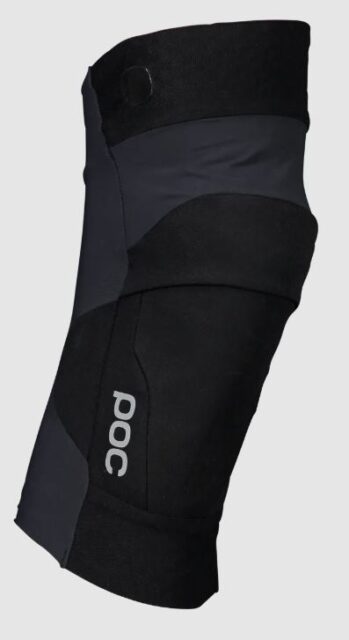
In addition to its fairly large and substantial-feeling main pad that covers the front of the knee, the Oseus VPD features a small piece of VPD padding on the inside of the knee, which I appreciate when I inevitably knock that area into the frame or seat of my bike.
Overall, the Oseus VPD is a very protective pad that also happens to be pretty light and fairly breathable. It’s become my go-to pad for bike park days, and I’ve also put in plenty of uphill miles with it, though that’s usually done with it at my ankles during the ascent.
David: I’ve gotten along well with a bunch of POC’s other pads, but the Oseus VPD really didn’t work for me. Like Luke, I found them to chafe pretty badly after more than a few minutes of pedaling. And while the Oseus VPD does breathe better, I’d still prefer even the VPD 2.0 (which is definitely a burlier, more protective pad) for all-day pedal duty for that reason.
MSRP: $80
Reviewer: Dylan Wood (5’10”, 158 lbs / 179 cm, 72 kg)
Size tested: M
Measured weight per pad: 170 g
Certification: n/a
POC’s Joint VPD Air Knee pad serves as a lighter, more pedal-friendly alternative to the more downhill-oriented Joint VPD 2.0 Knee. It’s also notably cheaper and has a more simple design than the Joint System VPD and Oseus VPD Knee pads. I like to wear knee pads going both up and down, whenever I am on the bike, and the Joint VPD Air has been great for that.
The Medium VPD Air fits my knees very well. Initially, I was worried that they’d be too big for my relatively skinny legs (my thigh circumference is 41 cm measured at 10 cm above my kneecap, and my calf circumference is 34.5 cm, putting me between POC’s S and M sizes), especially given that I’ve preferred size Small POC knee pads in the past. But, I found that the VPD Air stays in place nicely on my knees, all while feeling very comfortable and nonrestrictive. The VPD Air features an adjustable elastic strap with velcro fastening over the lower thigh, as well as two anti-slip neoprene strips at the top and bottom of the pad.
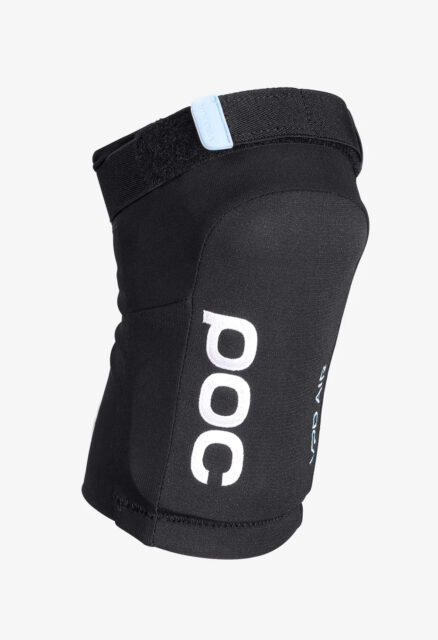
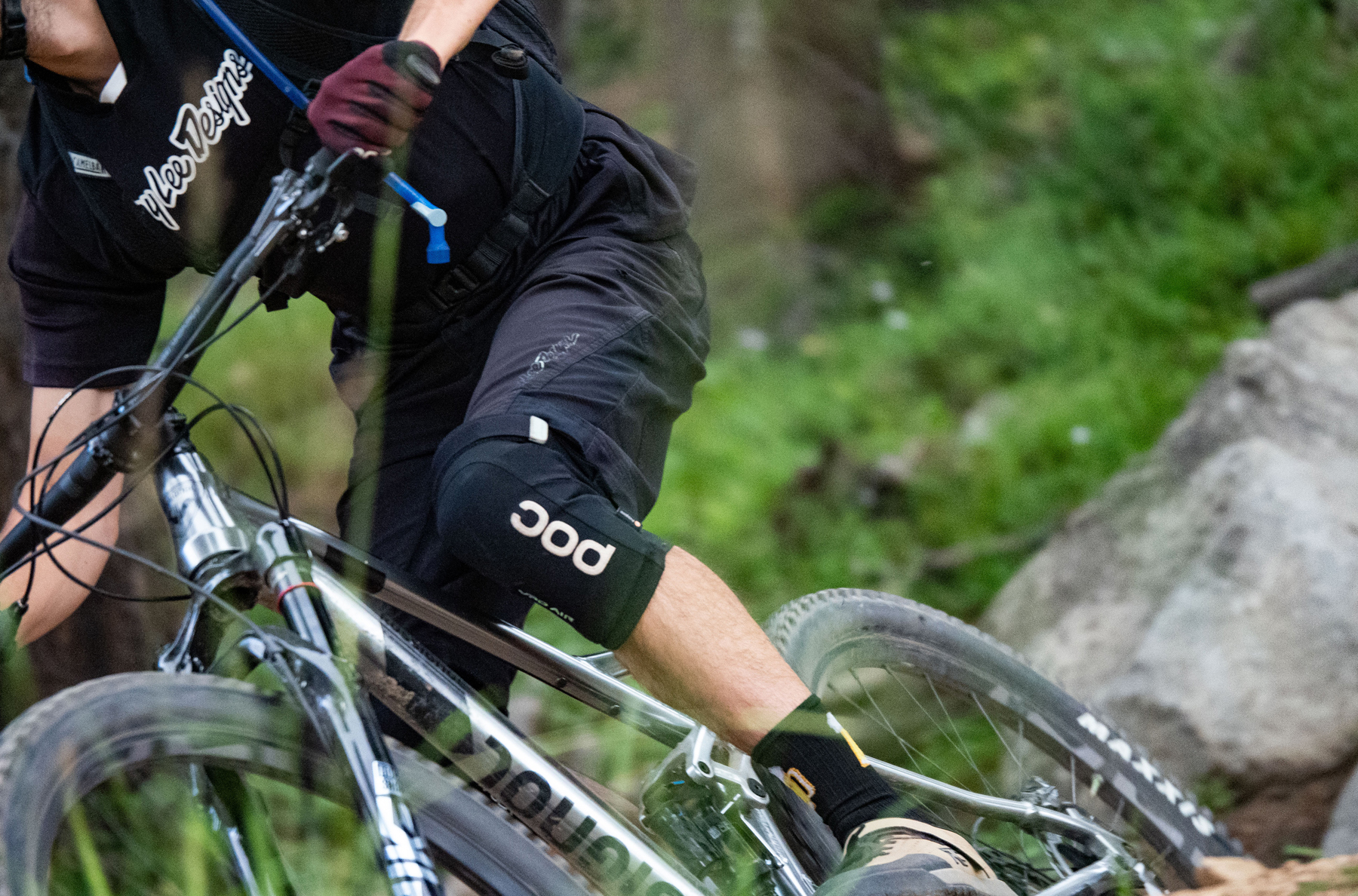
The VPD Air offers pretty nice protection on the way down, given how comfortable and pedal-friendly it is. It uses a single layer of POC’s VPD Air padding over the knee, which is very pliable, but stiffens on impact. This VPD Air padding also extends down the outside of the knees, and slightly further down inside the knees. I found this padding on the inside of the knees super helpful for protecting my knees against impacts from my frame and saddle, which happens to me often.
Luckily, I haven’t had many severe crashes in the season and a half that I’ve been using the VPD air, but after some smaller spills as well as a couple of bigger crashes, I’ve always come out of them with totally unscathed knees. The “reinforced stretch fabric” doesn’t seem quite as durable as the outer fabric of POC’s VPD System Knee pad, and might not withstand high-speed, sliding crashes as well.
So, if you value a good mix of protection and comfort both uphill and downhill, the VPD Air is certainly worth considering. There are options out there that offer a bit more protection, such as the VPD 2.0, but the VPD Air is a well-balanced knee pad that doesn’t break the bank.
MSRP: $95
Reviewer: David Golay (6’, 170 lb / 183 cm, 77.1 kg)
Size tested: M/L
Measured weight per pad: 158 g
Certification: CE EN 1621 Level 1
The Troy Lee Stage is something like a slightly thinner, more breathable version of the 7iDP Transition (the Stage is still much closer to the Transition than the Sam Hill Lite) in that the Stage uses a similar sleeve design that extends far up the thigh, and it’s meant to be a middle-ground pad that’s reasonably protective while still being comfortable to pedal in. The Stage uses a D3O non-Newtonian insert for the padding, which is heavily perforated for ventilation, but is sewn directly into the sleeve that houses it, in contrast to the removable inserts in many of the other pads, above. It’s tough to tell for sure since the insert is sewn into the Stage, but it appears to likely be the same one that’s used in the Akta Trail, Fox Launch Elite, and Race Face Indy.
The sleeve portion of the Stage doesn’t extend quite as far up the thigh as that of the 7iDP Transition or Sam Hill, but it’s still on the longer side and successfully moves the silicone gripper high enough up my leg to avoid any issues with chaffing or the pads slipping down as I pedal. It’s also notably thinner and more breathable than the sleeve used in the Transition, for better and worse. The sizing of the Stage also feels pretty true to their M/L label — I typically wear a Medium in most pads, and while the M/L still definitely feels like the right size for me, they’re a little looser fitting than most true Mediums.
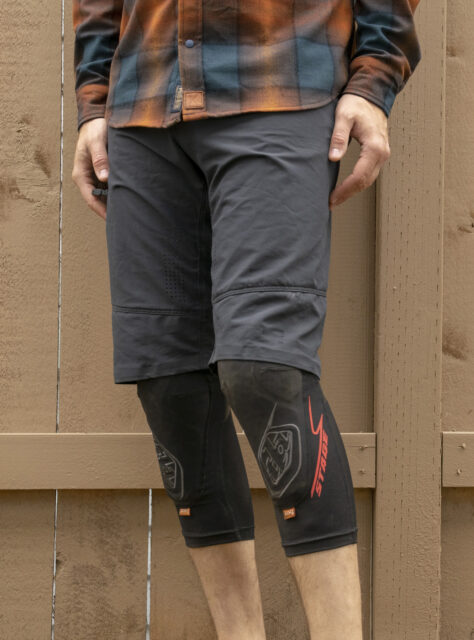
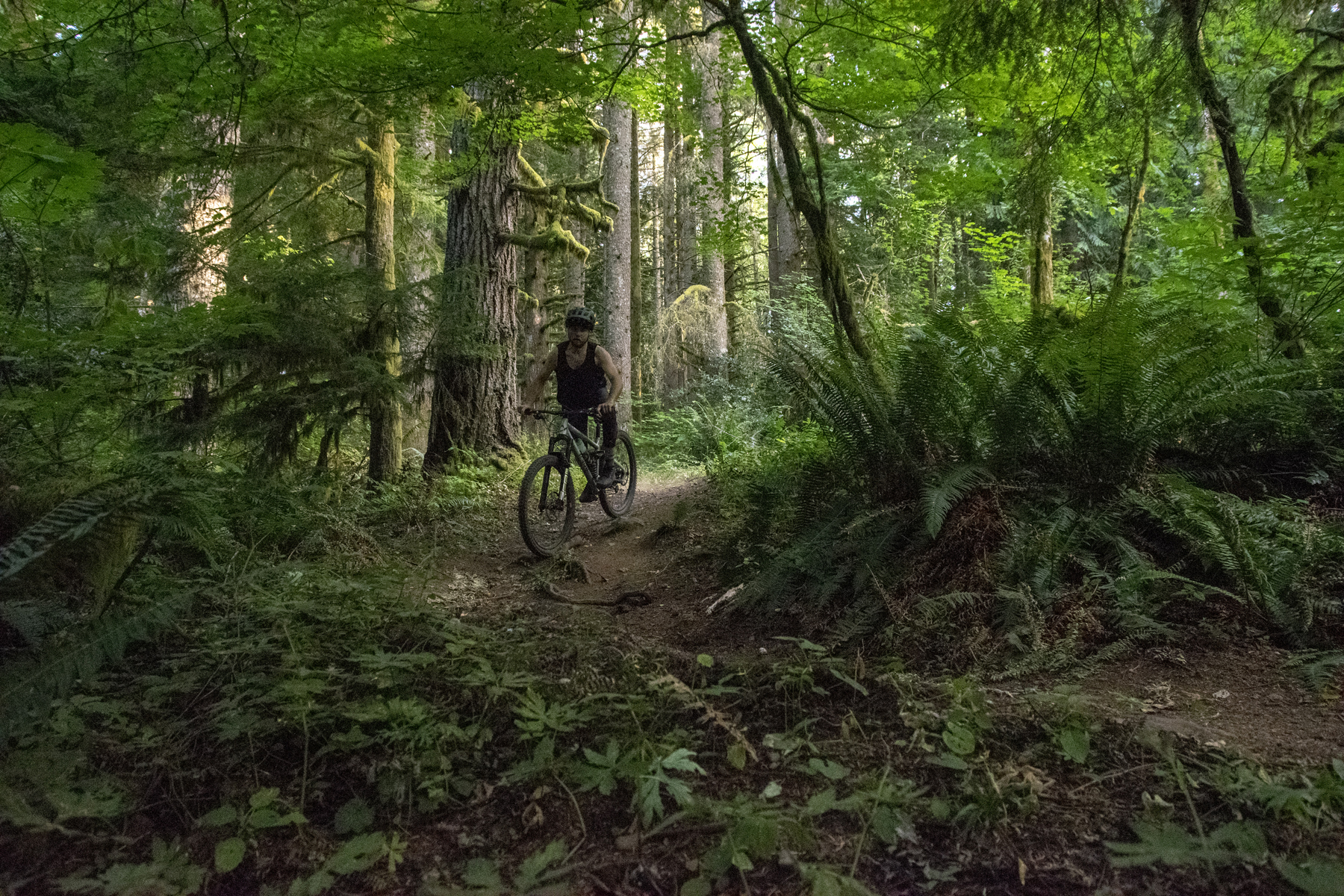
That’s too bad, because I found the Stage to be impressively comfortable and breathe super well. Maybe a little too well, since the lighter fabrics didn’t hold up to hitting the ground very well. I’d love to see Troy Lee make a slightly burlier version, because the fit of the Stage is absolutely dialed (for me) and the design shows a ton of promise. The flimsy mesh sleeve just let me down.






Having also spent a bunch of time with a few of these pads, I’ll chime in with a few comments on fit.
* Pay attention the the Launch Elite size chart. I’m 5’8″, 165, and wear a medium in just about everything, but according to the Fox size chart, I wear an XL for the Launch Elite knees and elbows. That size does indeed seem to be correct for me, although I *might* be able to size down into a L. As it is, the knee grippers go very high on my thighs but feel very snug and do not move at all. The sock material is a bit looser than any other pad of this style, which helps make them quite comfortable. If anything, they feel maybe a tad long, so maybe a L might be more ideal. The elbow version is a similar situation – the sleeve (especially forearm is a tad looser) but the upper gripper band is snug, and they are the first pair of elbow pads I’ve worn that don’t give me arm pump within a couple minutes of wear.
* As someone with shorter legs, on pads with the extra padding ring (Akta & Sam Hill), I find they tend to rub my upper shin. I’m guessing it’s due to combination of knobby knees and short shin bones. But it’s definitely related to something with that extra ring of padding because as the article points out, the Akta shares the same insert as the Launch Elite which doesn’t have that issue for me. I prefer to wear them with shorts, so that I can adjust them up or down a little bit to try and avoid that shin chafing.
Not reviewed here, but the Rapha Trail Knee Guard combines a lot of the best features of the Stage and Launch Elite. It’s got very smooth fabric which doesn’t rub or chafe, and the sleeve extends high up on the thigh with a very wide gripper band. The grippers themselves are a series of vertical lines, which I find irritates my skin less but still stays in place well. The “super fabric” face to the knee itself is like the Launch Elite, and is pretty durable. The impact protector itself is by Rheon (I think the same one as in the Chromag Rift). Unfortunately I did have the sleeve tear above the pad (similar to the reviewer on the Stage) on a high speed crash, and while Rapha offered me a crash replacement discount, they’ve been out of stock for months. I’ve had the same thing happen with a pair of Sam Hills and Fox Enduros. That said, the Rapha remains my go-to knee pad for long, pedal-y rides. When I want more protection, I use the Launch Elite for longer/cooler rides, and the Aktas for shorter/hotter rides.
To get full marks, pads should come with the option to buy new replacement sleeves. It is ridiculous in this day and age that to replace the one torn sleeve of my 7idp Sam Hills, I have to buy a brand new pair incl armour pads and plastic bag carry case.
Sustainability matters guys, please step up
Good point!
I’ve also owned several of the pads mentioned here and a few that aren’t. My spectrum of use:
1. Bike park/shuttle: I mostly use the 7idp Sam Hills for this. I own a pair of the projects but have always found them too hot and uncomfortable for most use. Also, while the central padding is more robust on the projects than the Sam Hills, the Sam Hills have more wrap-around side protection and thus I feel more secure in them. Only real plus for the projects in my book is the hard plastic shell does indeed slide better over really dry soil and pointy rocks.
2. Enduro style riding (series of long climbs to more gnarly descents): I like a shorter, more easy on/off kneepad for this that I can drop down to my ankles for the climbs (I just don’t like doing long climbs with kneepads on the whole time). For this my favorite is the Leatt Airflex Pro. I’ve had a few samples over the years and keep coming back to this pad. I’ve used prior editions of the Dainese Trail Skin but much prefer the Leatt.
3. Trail riding (flowy trails, ups and downs, aka normal riding for most people): on the more mild XC stuff when I’m on my hardtail I typically skip knee pads all together. However if I want/need to wear pads my current favorite is the Rapha mentioned above. I’ve also used the Pearl Izumi Summit (very breathable but an overall small pad and not super protective) and the old Specialized Atlas (slightly more protection than the Pearl Izumi Summit but still not tons but very comfortable and breathable).